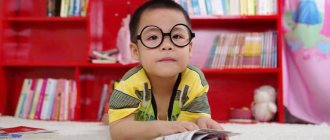Are there early characteristic warning signs that can be used to predict whether a child will subsequently develop dyslexia? What is the role of heredity? And is it possible to do something in advance - before the child begins to learn to read? The first results of the long-term research program are encouraging.
Fortunately, gone are the days when children with dyslexia were considered stupid or lazy. Anyone who still continues to think like this should be ashamed. Long-term multidisciplinary scientific research has irrefutably proven the old ideas wrong. Differences in the brain have already been identified in infants, and deviations are often noted in the speech development of children of primary preschool age if one of the parents has dyslexia. These are some of the findings of a ten-year Dutch dyslexia research program involving the universities of Nijmegen, Groningen and Amsterdam. This is one of the world's largest studies of dyslexia.
The largest part of the research was devoted to the development of very young children. Scientists studied the brains of pre-verbal infants who had at least one parent with dyslexia. They looked for features that could lead to the development of dyslexia in the future. In practice, this meant that children were followed over an extended period of time at one of the participating centers in the research program.
Confession
Linguist Evelien Krikhaar says that in Groningen, parents who experienced learning difficulties in childhood show great motivation to cooperate.
This is important because the research is quite intensive. In laboratories in Amsterdam, Groningen and Nijmegen, 9 brain studies were performed on each child - the last study was carried out when the child was 41 months old. Something like a rubber swimming cap was placed on the child's head, into which a large number of electrodes were installed to measure the electrical activity of the brain. Based on the fact that children with dyslexia have difficulty distinguishing between sounds, the infant heard the word "buck" interspersed with the word "duck" from time to time. The brains of infants in the control group - without a hereditary risk of dyslexia - already at two months of age gave a “inconsistency response,” i.e. was able to unconsciously notice the difference. At-risk infants—those from families with at least one parent with dyslexia—showed significantly reduced or delayed nonconformity responding. “An amazing result,” says Krikhaar. "It's interesting that there are differences between groups of children as their brains continue to develop."
Future prospects
Most parents, even when identifying the first symptoms of dyslexia, panic: what kind of work and serious career growth can we talk about with such a diagnosis! Believe me, everything is not so terrible.
Dyslexia is often called . ” Famous personalities earn huge sums of money despite this violation.
Vin Diesel, the brutal star of The Fast and the Furious, was able to build a successful acting career while being dyslexic.
Keanu Reeves, without having a secondary education, made billions of people think about the artificiality of our world by playing in The Matrix.
The list also includes Daniel Radcliffe, who earned millions even before he came of age.
“The disease of geniuses” sometimes becomes a difficult test both for the owner himself and for his relatives. Do not despair and do not worry about the fate of your treasure: being different from others is not fatal. Dyslexia, with due attention from parents, does not prevent children from having a great life.
We also recommend watching the Indian film about a boy with dyslexia, “Stars on the Ground.”
Speech development
The speech development of children was also studied, starting at the age of 17 months. It turned out that children at risk had delayed speech development. The researchers were surprised by the results of verb conjugation. It turned out that children from the risk group used the correct form in the test, and children from the control group used the incorrect form. It has also now been scientifically proven that children at risk of developing dyslexia are no dumber than other children. The researchers used an intelligence test that was once developed to screen young deaf children. Krikhaar: "Wonderful, beautiful test. And both groups showed the same result.”
Although the program has been ongoing for ten years, final results are not expected until 2012. This is because at the start of the program it took two and a half years to recruit enough participants: 180 children with an inherited risk of dyslexia and a control group of 120 children without such risk. A lot of time was spent searching for pregnant women willing to participate in the study and quickly testing adults for the presence of dyslexia with a specially designed test. The final results will be obtained after children are tested for dyslexia at the age of 9 years.
Kinds
The varied symptoms of dyslexia allow us to distinguish the following types of dyslexia:
- Agrammatic dyslexia - confusion in genders, cases and numbers (“delicious candy”).
- Phonemic - syllables and paired consonants are swapped (v-f, b-p).
- Semantic dyslexia is a lack of reading comprehension. A simple analogy is a text spoken by a computer program that is unable to grasp the meaning.
- Optical dyslexia – letters with similar spellings (r – ь, sh-shch) are confused. Mnestic dyslexia - the relationship between a letter and the corresponding sound cannot be understood in the head.
- Such forms of dyslexia are much more common than tactile dyslexia - the inability of blind children to understand the dotted letters in Braille.
Heredity
In the search for early warning signs of dyslexia, heredity studies play an important role. In Nijmegen, Dr Barbara Franke is studying the genetic origins of dyslexia. Using material from three large families in which many people suffer from dyslexia, she investigated the genetic causes of this condition. Franke: “In one of the three families examined, it was actually possible to find a place on the X chromosome in which the dyslexia gene may be located.” Franke focuses on this particular family. "There is no gene for dyslexia. We think that most often we are dealing with the accumulation of small genetic defects."
Causes
The prerequisites for the onset of the disease are always associated with neurobiological factors - the incorrect functioning of neurons between the cerebral hemispheres. There are different possible etiologies for dyslexia.
Before conception:
- Mutation
- Genetic predisposition - the presence of similar difficulties in close relatives increases the chance of developing pathology in the fetus.
In the womb:
- Intoxication (alcohol, smoking, drugs, chemicals)
- Hypoxia
- Viruses (jaundice, herpes, influenza)
- Placental abruption
At the moment of birth:
- Weak or absent contractions
- Stagnation in the birth canal
- Drug induction of labor
- Kristeller's maneuver, or squeezing out the newborn by applying pressure to the mother's abdomen
- Umbilical cord entanglement
Causes of dyslexia after it:
- Hidden left-handedness, or right-hemisphere brain activity
- cerebral palsy
- Developmental delay
- Viral infections (measles, chickenpox, polio, measles rubella)
- TBI
Prevention
The third major area of scientific research, begun in 2002, is the study of the effectiveness of preventive interventions.
Approximately 160 five-year-old children with one parent with dyslexia were worked at universities in three cities to give them an advantage before entering 3rd grade .
). They were worked with in different ways: students or parents, there were different offers of help: traditional - with personal contact - or using a computer, with an emphasis on naming objects, distinguishing letters, pronouncing sounds or building a vocabulary from simple words.
At the end of the second year of study (6 years), it turned out that children in all projects showed better results in writing and phonics than the control group, which did not receive such support. Problems persisted only with the speed of naming words.
“Unfortunately, this effect persisted for many years,” notes Prof. of Orthopedagogy at the University of Amsterdam Aryan van der Leij. "We were surprised that all this extra baggage didn't help when the child actually started learning to read."
This was not the only surprise. Studies of the brains of this group of children show that the brains of children at risk (one of the parents has dyslexia) who do not develop dyslexia are still different from the “normal” brain. Van der Leij: "This group occupies a kind of intermediate position, and that is very significant." Another important finding is that at-risk children performed reasonably well in 3rd grade, but by the end of 4th grade, at least 31% were performing worse in reading, and by the middle of 5th grade, the figure was 42%. Van der Leij: “This means that in the area of language, reading problems appear later. As the pace of reading accelerates, these children drop out.” Based on the results obtained, Van der Leij believes that intervention should be carried out in the 3rd and 4th year of education (i.e. at the age of 6-7 years).
The most intriguing question of the entire study is how a child at risk of dyslexia will develop further. Why does one person have dyslexia and another does not? “It appears that there is a certain compensatory mechanism in the brain,” says Professor Natasha Maurits, chair of the Dyslexia Research Group. "This should be studied further."
Exercises
- Making up stories based on a group of pictures.
- Memorizing poetry (expands vocabulary and activates memory).
- Retelling your favorite book passages.
- Magnetic alphabet games.
- Composing letters and syllables from sticks, pencils, cubes, and threads of colored yarn.
- Tongue twisters and articulation exercises.
- Letter stencils.
- Drawing words with your fingers on the child’s body and then asking them to decipher what they drew.
I.N. Sadovnikova
offers children the following technology to overcome dysgraphia and dyslexia:
- Correct sentences with errors in certain parts.
- Insert missing letters.
- Count syllables, vowels and consonants.
- Name objects starting with a given letter.
- Conduct sound-letter analysis.
- Feel the alphabet made of cardboard, associate the letters with familiar objects.
- Use copybooks and ABC books with bright pictures.
Prevention
The etiology of dyslexia is very extensive. In order to minimize risks, a pregnant woman should be careful about her health, strictly follow the instructions of the medical staff of the maternity hospital and avoid contact with patients before and after the birth of a small miracle. Such measures are the best prevention of dyslexia.
One hundred percent prevention of dyslexia is impossible. However, there are ways to minimize risks.
Illustration: a family with dyslexia
- Father – Maurits Krul (47 years old), senior researcher at the Institute for Migration and Ethnic Studies: “Officially I do not have dyslexia. But it was a revelation when my son was diagnosed with dyslexia. He made the same mistakes that I made as a child: “b” instead of “d”, and eternal confusion with “d” and “t”.
When I went to school, there were no names like dyslexia, highly gifted child, or attention deficit hyperactivity disorder (ADHD). You were simply considered a careless and unfocused student. Now, looking back, I regard my elementary school experience as extremely unpleasant. I never had confidence that I did the tasks correctly. My writing was terrible and full of mistakes. I felt like I couldn't handle it and often felt incompetent.
Dyslexia is a permanent disability and cannot be corrected. But there are also positive sides. Since I don't write very well, I compensate with my verbal abilities. I have always been good at oral presentations and presentations. As for reading, I am a “complementary reader,” i.e. I select words that I recognize from the text and then fill in the gaps. I grasp the essence of the text very quickly and easily make connections within it. When I was studying, many of my fellow students spent a lot of time to master the topic, but half a word was enough for me.”
“Spell checking on the computer was a huge help for me. Now I can quickly correct the mistakes myself, and my uncertainty has disappeared. It was different during my school days. Then I wrote my thesis with the help of my wife. On a typewriter.
My problems seem insignificant to my wife. She speaks six languages and reads a lot. She always told me that I wrote too briefly and concisely, and she paid too much attention to beautifully structured sentences. Ultimately, she was the one who helped me learn to write better: I had to write as I spoke. Verb conjugations and tense agreement don't mean anything to me, but if I can record myself speaking, it's no problem. I even receive compliments that I write so clearly and accessible to a scientist. I publish in English and Dutch, do final editing of texts, and read a lot. You must accept that you will never read and write like others do, but you will have your own style. This has its disadvantages, but also its advantages...
- Mother – France Lely (44 years old), project assistant at the Institute for Migration and Ethnic Studies at the University of Amsterdam: “Maurits’ and children’s dyslexia completely changed my ideas about language and speech. I love reading. At first I was annoyed that Maurits made the same mistakes over and over again. But the more I learned about dyslexia, the more I resisted paying attention to spelling. This was a major setback for my husband and children.
“On the other hand, when we heard that our son has dyslexia, we breathed a sigh of relief. You know, it’s unpleasant to think that your child is a careless and lazy student, and now I blame myself for thinking so. But we just didn't understand it. About Maurice, I thought that he wasn’t trying hard enough. And then two children with dyslexia appeared in our family. At that time, the husband was burdened with his own memories of difficult school times. This was a revelation for him.
“It’s funny that at home I act as an expert in the field of dyslexia. I go to educational conferences and read everything on the topic. I am an advocate for my family's interests. I write all the letters, look through all of Zeb's homework and my husband's articles.
“We already knew about Vera’s dyslexia when she was only three years old. She repeated what we had previously observed in our son. She was not interested in letters, she could not name colors, time and money were extremely difficult concepts for her. But she has other qualities: she has a rich imagination, she is creative, she loves to draw, she loves music, she is good at skating and swimming. She is always busy with something. An image of something appears in her head, and she accurately reproduces it in detail. I'm not worried about the future of my children. Maurits is a good example of how you can be successful with dyslexia. Unfortunately, they have a hard time at school - there is too much emphasis on reading and writing...
- Daughter - Vera Lely (7 years old), a 4th grade student at primary school: “My friend reads so fast that I don’t understand. I read and write poorly, I need to spell everything. This is because I have dyslexia. At school, if we write something, then we have to check it and then hand it in to the teacher. But I, even after my check, have a huge number of errors, because I do not see the differences between letters and words. I study a lot. I have a special book in which I write down my passwords for accessing the school computer and the like. From the teacher I learned to read using different colors. Then certain letters or their combinations are highlighted in a different color. Things are going well for me, except for “d” and “b”. They are both blue and I can't tell them apart. My mother and I read a lot together. When I grow up, I will read and write, but this is not the main thing. I want to become a fashion designer. I draw well - better than my neighbor at my desk. I help her with drawing, and she helps me with writing. Also, I count to ten in Chinese, English and German.
- Son - Zeb Lely (18 years old), sixth grade of high school: “I was diagnosed with dyslexia in high school. Then my Dutch teacher gave me a test in the first month of school, and according to the results it turned out that I had dyslexia.
“But I didn’t make enough mistakes to officially declare me dyslexic – two or three mistakes. This means that I did not have the right to any concessions - neither for additional time, nor for the use of a laptop when writing text. They then told me: “You have dyslexia, but we can’t do anything for you.”
“I myself have not experienced any particular problems with dyslexia. I was 12 years old, I was studying. I was the only student with dyslexia in the class, but this did not in any way affect my position among my classmates. I helped a friend with geography, and he helped me with Dutch. When I had to choose a further profile of study, I, of course, did not choose the language package. I chose the "Economy and Society" package. I have good grades. I write briefly, which earns extra points.
"It's always harder for me to write. And now, when the political science course begins. But what helps here is that I can work on a computer because I type 20 times faster than I write.
»I have good English. It just happened that way. Foreign friends of my parents often come to visit us, and I watch TV. But music especially helped. I listen to a lot of hip-hop music, and the lyrics are important. Now I even earn extra money by teaching English lessons to schoolchildren. Speaking English is not a problem for me, and in listening (listening comprehension) I was the best in the class. But there was a problem with the spelling: out of 14 words, I spelled nine incorrectly. But my students, on the contrary, write well; they have a problem with speaking.
“It helps that my father is also dyslexic. Parents understand that things do not always go well at school. But I worry when I look at my sister. She still has to go through all this...








